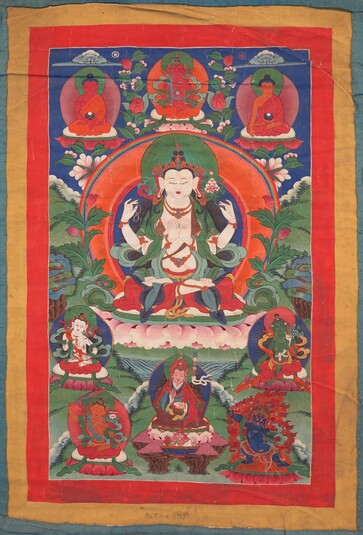
Item: Avalokiteshvara (Bodhisattva & Buddhist Deity) - Chaturbhuja (4 hands)
| Origin Location | Tibet |
|---|---|
| Date Range | 1800 - 1899 |
| Lineages | Buddhist |
| Material | Ground Mineral Pigment on Cotton |
| Collection | Bodleian Libraries , University of Oxford |
Alternate Names: Lokeshvara Avalokita Lokanata Lokanatha Mahakarunika
Classification: Deity
Appearance: Peaceful
Gender: Male
Avalokiteshvara, Chaturbhuja (Tibetan: chen re zi, chag shi pa. English: the All Seeing Lord with Four Hands)
At the center is the white four-armed Lokeshvara. At the top center is red Amitayus Buddha with Amitabha Buddha on the left and Shakyamuni Buddha on the right. At the lower left is white Vajrasattva with orange Manjushri below. At the lower right is Green Tara with blue Krodha Vajrapani below. At the lower center is the 8th century Indian teacher Padmasambhava.
"As the nature of all buddhas, Avalokiteshvara, in colour like stainless conch and crystal, very resplendent, smiling, peaceful and radiant. With four hands the first are folded at the heart, the lower hold a crystal mala and jeweled lotus, two beautiful feet seated in vajra posture, adorned with many attractive silks and jewels, beautified with dark blue hair in tufts [some] loose. On the crown of the head, the wisdom of all buddhas, is the Lord, source of all refuge gathered as one, in essence the Guru in the aspect of Amitabha, in the manner of the Lord of the Family, seated happily." (Ngorchen Konchog Lhundrub 1497-1557).
Avalokiteshvara is understood as both a bodhisattva from the Mahayana tradition of Buddhism and a fully enlightened Buddha and meditational deity in Vajrayana Buddhism. He is acknowledged as the patron bodhisattva of Tibet and is practiced by all traditions. There are numerous 'Sarma' new lineages and different forms of practice which span all four tantric classifications as well as uncounted 'Kama' early oral and 'Terma' (treasure) traditions from the Nyingma School of Tibetan Buddhism.
Jeff Watt 6-2014
Buddhist Deity: Avalokiteshvara, Chaturbhuja - Four Hands - Main Page
Collection of Bodleian Libraries, University of Oxford

